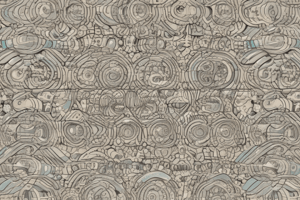Podcast
Questions and Answers
What is the main purpose of the Prototype pattern?
What is the main purpose of the Prototype pattern?
- To create new objects from scratch.
- To define families of related objects.
- To clone existing configured objects. (correct)
- To manage memory allocation for objects.
Which class is responsible for implementing the cloning method in the Prototype pattern?
Which class is responsible for implementing the cloning method in the Prototype pattern?
- Client
- PrototypeRegistry
- AbstractFactory
- ConcretePrototype (correct)
What does the PrototypeRegistry class primarily manage?
What does the PrototypeRegistry class primarily manage?
- Concrete objects from multiple families.
- Complex dependencies between multiple prototypes.
- A collection of pre-built objects for cloning. (correct)
- The instantiation of new classes.
In the context of the Abstract Factory pattern, what is a key requirement when developing related products?
In the context of the Abstract Factory pattern, what is a key requirement when developing related products?
When would a developer prefer using the Prototype pattern?
When would a developer prefer using the Prototype pattern?
What is a primary function of the clone method in the Prototype pattern?
What is a primary function of the clone method in the Prototype pattern?
Which of the following statements best describes an Abstract Factory?
Which of the following statements best describes an Abstract Factory?
In the furniture shop simulator scenario, which pattern would be most useful for ensuring that different furniture objects are created in a consistent manner?
In the furniture shop simulator scenario, which pattern would be most useful for ensuring that different furniture objects are created in a consistent manner?
What is the main purpose of the Flyweight pattern?
What is the main purpose of the Flyweight pattern?
In the context of the Flyweight pattern, which part of an object is considered state-dependent?
In the context of the Flyweight pattern, which part of an object is considered state-dependent?
What causes the game to crash during gameplay according to the provided problem?
What causes the game to crash during gameplay according to the provided problem?
How does the Flyweight pattern manage state-independent and state-dependent properties?
How does the Flyweight pattern manage state-independent and state-dependent properties?
What role does the Facade play in the subsystem according to the content?
What role does the Facade play in the subsystem according to the content?
What is indicated about the encapsulated objects in the Flyweight pattern?
What is indicated about the encapsulated objects in the Flyweight pattern?
What can be inferred about the subsystem classes in relation to the Facade?
What can be inferred about the subsystem classes in relation to the Facade?
What is a potential consequence of not using the Flyweight pattern in a memory-intensive application?
What is a potential consequence of not using the Flyweight pattern in a memory-intensive application?
What is the role of the Collection interface in managing iterators?
What is the role of the Collection interface in managing iterators?
How do concrete collections handle iterator requests from clients?
How do concrete collections handle iterator requests from clients?
In the Observer pattern, what is the publisher responsible for?
In the Observer pattern, what is the publisher responsible for?
What describes the concept of subscribers in the Observer pattern?
What describes the concept of subscribers in the Observer pattern?
What does the Decorator pattern use to add functionality to an object?
What does the Decorator pattern use to add functionality to an object?
What illustrates a potential issue with the store emailing all customers about new products?
What illustrates a potential issue with the store emailing all customers about new products?
What role does the Base Decorator class play in the Decorator pattern?
What role does the Base Decorator class play in the Decorator pattern?
What is the primary function of the publisher in this mechanism?
What is the primary function of the publisher in this mechanism?
What is the main benefit of using interfaces in the relationship between clients and collections/iterators?
What is the main benefit of using interfaces in the relationship between clients and collections/iterators?
In which situation would you typically use the Decorator pattern?
In which situation would you typically use the Decorator pattern?
Which of the following must all subscribers implement?
Which of the following must all subscribers implement?
How does the publisher communicate with its subscribers?
How does the publisher communicate with its subscribers?
What is the key function of the subscription mechanism in the Observer pattern?
What is the key function of the subscription mechanism in the Observer pattern?
What is a characteristic of Concrete Decorators in the Decorator pattern?
What is a characteristic of Concrete Decorators in the Decorator pattern?
Which of the following best describes the relationship between concrete classes and the client in this context?
Which of the following best describes the relationship between concrete classes and the client in this context?
Which of the following correctly describes the relationship between decorators and components?
Which of the following correctly describes the relationship between decorators and components?
What is the purpose of passing contextual data along with the notification method?
What is the purpose of passing contextual data along with the notification method?
What action does the publisher take when an event occurs?
What action does the publisher take when an event occurs?
What should the client code do when utilizing decorators?
What should the client code do when utilizing decorators?
What does the Subscriber interface typically consist of?
What does the Subscriber interface typically consist of?
What is the main advantage of using a decorator in code?
What is the main advantage of using a decorator in code?
What does the structure of decorator objects typically resemble?
What does the structure of decorator objects typically resemble?
What is a key characteristic of the subscription infrastructure provided by the publisher?
What is a key characteristic of the subscription infrastructure provided by the publisher?
How can the publisher pass additional information to the subscribers?
How can the publisher pass additional information to the subscribers?
Flashcards are hidden until you start studying
Study Notes
Prototype Pattern
- Prototype pattern allows developers to clone pre-configured objects instead of creating them from scratch.
- Prototype interface defines the cloning methods (usually a single
clone()method). - Concrete Prototype class implements the
clone()method to copy the original object's data and handle any edge cases of the cloning process. - Client class can create a copy of any object that follows the prototype interface.
- Prototype Registry provides easy access to frequently used prototypes by storing them and their copies.
Abstract Factory Pattern
- Abstract Factory pattern enables the creation of families of related objects without specifying their concrete classes.
- Example: A furniture shop simulator with different furniture families like modern, art deco, and Victorian, allowing the creation of objects within each family.
- The pattern prevents code repetition by providing a way to get instances of particular families without having to know the specific product types.
Decorator Pattern
- Decorator pattern lets developers customize existing objects dynamically by adding new functionalities through wrappers.
- The pattern allows for extending an object's behavior at runtime and wrapping multiple decorators around a single object.
- The wrapper object has the same methods as the target object and delegates requests to the wrapped object while adding additional behaviors.
- Example: Adding notification functionality to a base Notifier object using decorators, each decorator extending the functionality.
Facade Pattern
- Facade pattern provides a simplified interface for accessing a complex subsystem. It hides the complexity of the subsystem behind a single unified interface.
- Simplifies the interaction with the subsystem for clients.
- Example: A facade for a complex payment system, allowing clients to interact with it through a single interface.
Flyweight Pattern
- Flyweight Pattern aims to decrease memory usage by sharing common data between multiple objects.
- It separates object data into intrinsic and extrinsic states.
- Intrinsic state remains constant and is shared among objects. Extrinsic state is unique to each object and passed to the flyweight object when needed.
- Example: In a video game, particle system objects can share color and sprite information, while individual particles have unique coordinates, movement, and speed.
Iterator Pattern
- Iterator pattern provides a consistent way to traverse a collection object without revealing its internal structure.
- Iterator interface defines methods for traversing a collection.
- Concrete Iterator class implements the traversal logic for a specific collection type.
- Client works with collection and iterators through their interfaces, enabling flexibility and adaptability to different collections.
Observer Pattern
- Observer pattern defines a one-to-many dependency between objects, allowing multiple observers to receive updates from a single object.
- Publisher object notifies its subscribers about changes in its state.
- Subscribers implement a notification interface and receive updates from the publisher.
- Example: A store (publisher) notifies customers (subscribers) about new products, allowing them to subscribe to updates and receive notifications.
Studying That Suits You
Use AI to generate personalized quizzes and flashcards to suit your learning preferences.




